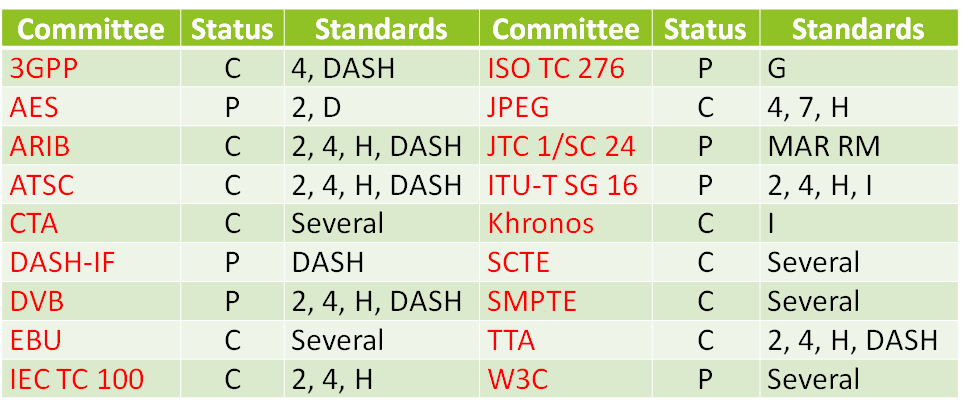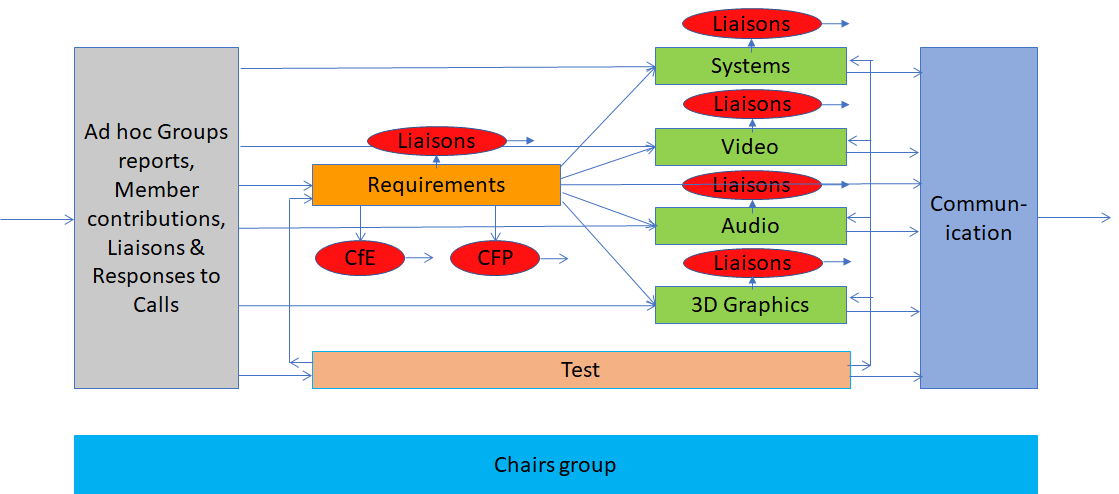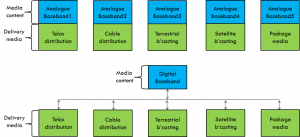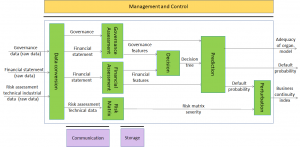Introduction
In its MPEG and JPEG as SCs proposal, MPEG Future proposes that MPEG become a subcommittee to improve collaboration with other bodies, establish a clear reference in ISO for the digital media industry, enhance group’s governance and more. The obvious question to MPEG Future concerns MPEG’s adequacy for the new role. The first answer to this question is that, in its original proposal, the Italian National Body UNI has already carried out a SWOT (Strengths-Weaknesses-Opportunities-Threats) analysis.
In No one is perfect, but some are more accomplished than others I have started rewording, expanding and publishing that SWOT analysis and in this article I will continue the task.
The Italian National Body has identified the following Key Performance Indicators (KPI) of a standards committee like MPEG: Context, Scope of standards, Business model, Membership, Structure, Leadership, Client industries, Collaboration, Standards development, Standards adoption, Innovation capability, Communication and Brand.
In the article mentioned above I have dealt with Context, Scope of standards, Business model and in this one I will deal with Membership, Structure and Leadership.
Membership
I would like to identify four levels of members: those who actually attend MPEG meetings, those who are officially registered as members but do not attend, those who actually work in MPEG projects without being officially members and those who, even without being members, have their work significantly influenced by MPEG work plan and standards.
Membership – as defined above – is the most valuable MPEG asset. It is because of this that the MPEG Future Manifesto has identified “Support and expand the academic and research community which provides the life blood of MPEG standards” as the first of its actions.
Strengths
MPEG has a level 1-2 membership competent in all areas of scope, large in number (level 1 is 500 and level 2 is 1500 experts), from many different industries with a growing role of academia and global (>30 countries). Level 3 membership is estimated at a few thousand experts and level 4 is estimated at a few tens of thousands. There is a continuous flow of level 1-2 experts leaving and being replaced by new experts, from level 3 and even from level 4.
Another strength is the fact that many level 1 MPEG members are active members of other organisations. This multiple membership facilitates understanding of other committees’ work, needs and plans. Table 1 identifies customers (those MPEG provides standards to) and partners (those MPEG works with, e.g. to develop standards).
Table 1 – Main customers (C) and partners (P)

Read Standards and collaborations to know more about the way MPEG does work with other committees.
Weaknesses
The main weakness comes from the fact that the percentage of level 1 experts coming from companies directly using MPEG standards is shrinking. This is the result of a phenomenon that is entirely outside of MPEG control but alters MPEG’s traditional relationship with its industries.
Related to the same phenomenon is the fact that the percentage of experts working for Non-Performing Entities (NPE) is growing. Of course, all experts are motivated to develop the best possible standards, but the ultimate goal of experts is changing compared to the traditional experts’ goal.
Similar to the above phenomenon is the fact that the percentage of academic members, currently at about 25%, is growing. Of course, injection of valuable academic know how is good but again the ultimate goal of experts is changing compared to the traditional experts’ goal.
Of a completely different nature is the weakness generated by one of the strengths mentioned above: the large number of level 1 members. The ISO/IEC directives say that WGs should be “limited in size”. Limited is not defined but, when one sees ISO Technical Committees of couple hundred members, ISO Subcommittees of a few tens and MPEG (a working group) of 500, that MPEG has exceeded the “limited size” is more than a suspicion.
A final main weakness is a consequence of the fact that MPEG attracts the best experts but, being a working group, does not attract managers who care about the organisational sustainability of MPEG in a world of standards. No level 1 MPEG member attends JTC 1 meetings where important policy decisions may be made that affect MPEG’s work plan and execution.
Opportunities
One of the most strategically important opportunities is how to make best use of the enormous brain power that populates MPEG meetings and activities, influences research and attracts new members.
This can be achieved by exploiting the opportunities for new standards in the MPEG traditional media field. MPEG is working in several areas such as immersive media, neural network compression and video coding for machines that will require a large number of experts making substantial contributions. Additionally MPEG can offer new perspectives in compression of data other than media, e.g. genomics.
From the organisational viewpoint MPEG can comply with the ISO/IEC directives while keeping the MPEG ecosystem intact, e.g. by achieving subcommittee status.
Threats
The biggest threat is that the MPEG membership is not an asset that is granted for ever. Members at all levels can leave without being replaced because the MPEG work plan may lose its attraction, or its standards are no longer relevant or profitable. A related threat is an overshoot of the attractionm to new members that is unable to reward all members at all levels.
Another set of threats is caused by the current discussions on the future of MPEG which is shaking the confidence of industry and experts. A breakup of MPEG in disconnected working groups would dramatically affect MPEG’s ability to deliver its existing work plan. Even if delivery is assured, there will be no guarantee that the quality of standards will remain the same because the glue provided by the MPEG organisation and modus operandi will be lost.
Structure
The MPEG structure is another major asset of MPEG. It is at the root of the quality, usability and ultimate success of MPEG standards.
Strengths
The biggest strength of the MPEG structure is the fact that it has not been designed by committee but is the result of a 30-year long learning process. Figure 1 depicts the structure with an indication of the flow of activities.

Figure 1 – Today’s MPEG structure and workflow
MPEG can be defined as an ecosystem of interacting subgroups developing integrated standards and, over three decades, MPEG subgroups were created and disbanded (see here for the full story) because the ecosystem shifted in nature. The subgroups in operation today are the best match to the current conditions, but may well change if the programme of work will change.
These are the main components of the MPEG ecosystem
- Ad hoc groups (AhG) were created since the early days (1990) because experts needed an “official” environment to continue doing work outside MPEG meetings, with the understanding that “decisions” could only be made when MPEG is in session.
- Break-out groups (BoG) existed since the early days because even a single part of a standard could be too complex and the work had to be split in separate activities to be merged later by the subgroup in charge of that part of the standard.
- Joint meetings are possible because the expertise of the MPEG membership covers all areas needed by MPEG standards. Whenever an MPEG standard needs to interface with another standard or expose an interface it is possible to get the relevant people together, discuss and take action on the issues.
- Chairs meetings are the place where the general progress of work is reviewed and the need for interaction between the elements of the MPEG ecosystem are identified.
- Finally MPEG benefits from powerful ICT tool developed by Christian Tulvan of Institut Mines Télécom to support document management, session allocation, work plan etc.
A more complete analysis of the MPEG ecosystem is found at MPEG: vision, execution, results and a conclusion.
An important strength is given by the fact the processess described above have taken root over many years and are now deeply ingrained in the collective mindset of mPEG members.
A final important strength is that, while MPEG does not have a formal strategic planning function, this is actually implemented by the diffuse structure described above.
Weaknesses
The main weakness of the current MPEG structure is a reflection of the main strength as described above. MPEG has an enormous brain power with extremely high levels of technical excellence but has weak links with the market.
This does not mean that MPEG is unaware of the market. Its processes include the development of context and objectives for a new project, the development of use cases and the analysis of use cases to develop requirements. However, all this is done by technical experts who, as the case may be, occasionally wear the clothes of market guys.
Because of its enormous brain power, MPEG has been able to develop many standards, some of which are extremely successful and other less so. Therefore, while there is no compelling need to address this weakness because MPEG standards are so successful, there is room for improvements.
Another significant weakness is the limitation in MPEG’s ability to initiate new collaborations with other committees because of MPEG’s inferior status in ISO.
Opportunities
MPEG Future’s MPEG and JPEG as SCs proposes that MPEG becomes a subcommittee with a new Market needs Advisory Group (AG). MPEG is a big thing. Can it be bigger? describes how the interaction between a technology driven Technical Requirements AG can compete and collaborate with the proposed Market needs AG to make more robust and justified proposals for new standards.
By becoming a subcommittee MPEG can also have more freedom to timely initiate collaborations with other committees and to actually establish formal collaborations with other ISO and IEC committees using the Joint Working Group )JWG) mechanism. Today, as a working group, MPEG may not formally do work with other committees if not by liaison.
Threats
The main threat is the possibility that, in the face of a large committee of 500 level 1 experts and 1500 level 2 experts, MPEG is simply broken up in its working groups or, worse, new working groups are created by recombining MPEG activities. Of course, given sufficient time and effort, a new different MPEG-like organisation may be created, but at the cost of delayed or inferior quality standards and without a guarantee that a committee-designed organisation will work as well as an organisation that is the result of a Darwinian process.
Leadership
By leadership here we mean the many people who hold a leadership position in MPEG: convenor, subgroup chairs, ad hoc group chairs and break-out group rapporteurs.
Strengths
Because of its oft-mentioned enormous brain power, MPEG is in the enviable position of being able to identify excellent leaders. Actually, MPEG does that for subgroup chairs but ad hoc group chairs and break-out group rapporteurs are very much the result of a bottom up process.
The main strength is given by the consolidated and experienced MPEG and subgroup leadership who is ready to delegate significant levels of authoomy to AhGs and BoGs, with the constraints imposed by the fact that formal adoption of technology is the competence of subgroups and ratification of decision is the competence of the MPEG plenary.
Weaknesses
The main weakness, going hand-in-hand with its main strength, is that leadership of MPEG and subgroups is rather static and that new leaders identified in AhG-BoG activities are not sufficiently put to good use.
Opportunities
With the implementation of MPEG Future’s MPEG and JPEG as SCs proposal, MPEG has the opportunity to introduce accelerated cycles of leadership regeneration in WGs, JWGs and AGs, and in a better management of the “unit” entity described in MPEG: vision, execution, results and a conclusion.
The MPEG Future proposal also incudes suggestions on new processes to nominate candidates as chair of the proposed new subcommittee by the Secretariat could be designed that preserve the ultimate authority of the Secretariat to decide in the framework of selections made by the MPEG community.
Threats
The MPEG structure and MPEG leadership are not disconnected entities. Today’s MPEG structure with an entirely new leadership would have a hard time to work smoothly and guarantee the delivery of the standards in the work plan with the quality that MPEG’s client industries expect. This does not mean that the leadership should stay static forever, simply that changes should be implemented in a progressive fashion.
Conclusions
In this article we have made a SWOT analysis of three of the most critical KPIs: membership, structure and leadership. MPEG is excellent in all three, but does have weaknesses. Opportunities for improvements are offered by MPEG Future’s MPEG and JPEG as SCs proposal, but threats are lurking.
Posts in this thread
- More MPEG Strengths, Weaknesses, Opportunities and Threats
- The MPEG Future Manifesto
- What is MPEG doing these days?
- MPEG is a big thing. Can it be bigger?
- MPEG: vision, execution,, results and a conclusion
- Who “decides” in MPEG?
- What is the difference between an image and a video frame?
- MPEG and JPEG are grown up
- Standards and collaboration
- The talents, MPEG and the master
- Standards and business models
- On the convergence of Video and 3D Graphics
- Developing standards while preparing the future
- No one is perfect, but some are more accomplished than others
- Einige Gespenster gehen um in der Welt – die Gespenster der Zauberlehrlinge
- Does success breed success?
- Dot the i’s and cross the t’s
- The MPEG frontier
- Tranquil 7+ days of hard work
- Hamlet in Gothenburg: one or two ad hoc groups?
- The Mule, Foundation and MPEG
- Can we improve MPEG standards’ success rate?
- Which future for MPEG?
- Why MPEG is part of ISO/IEC
- The discontinuity of digital technologies
- The impact of MPEG standards
- Still more to say about MPEG standards
- The MPEG work plan (March 2019)
- MPEG and ISO
- Data compression in MPEG
- More video with more features
- Matching technology supply with demand
- What would MPEG be without Systems?
- MPEG: what it did, is doing, will do
- The MPEG drive to immersive visual experiences
- There is more to say about MPEG standards
- Moving intelligence around
- More standards – more successes – more failures
- Thirty years of audio coding and counting
- Is there a logic in MPEG standards?
- Forty years of video coding and counting
- The MPEG ecosystem
- Why is MPEG successful?
- MPEG can also be green
- The life of an MPEG standard
- Genome is digital, and can be compressed
- Compression standards and quality go hand in hand
- Digging deeper in the MPEG work
- MPEG communicates
- How does MPEG actually work?
- Life inside MPEG
- Data Compression Technologies – A FAQ
- It worked twice and will work again
- Compression standards for the data industries
- 30 years of MPEG, and counting?
- The MPEG machine is ready to start (again)
- IP counting or revenue counting?
- Business model based ISO/IEC standards
- Can MPEG overcome its Video “crisis”?
- A crisis, the causes and a solution
- Compression – the technology for the digital age


